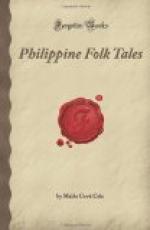[25] The water buffalo now used as the beast of burden throughout the Philippines.
[26] The ordinary dress of the Tinguian man is a clout and a striped belt, in which he carries his tobacco and small articles. Some of them also possess striped cotton coats, which they wear on special occasions.
[27] See note 2, p. 12.
[28] See note 1, p. 13.
[29] This peculiar idea, which frequently appears in Tinguian tales, is also found in Javanese literature. See Bezemer, Volksdichtung aus Indonesien, p. 47 (Haag, 1904).
[30] See note 3, p. 15.
[31] The powerful deeds of these heroes often resemble the miraculous achievements of biblical and ancient times.
[32] See note 2, p. 20.
[33] The Tinguian of today do not possess soap, but in its place they use the ashes from rice straw, or not infrequently they soak the bark from a certain tree in the water in which they are to wash their hair.
[34] The lawed vine. In ancient Egypt and in India it was a common belief that friends or relatives could tell from the condition of a certain tree or vine whether the absent one was well or dead: if the vine thrived, they knew that all was well, but if it wilted they mourned for him as dead. It is interesting to find the identical belief in the northern Philippines.
[35] The Tinguian stove consists of a bed of ashes in which three stones are sunk, and on these the pots are placed.
[36] It appears that these people of ancient times possessed the same weapons as those of today. The Tinguian ordinarily wears a head-ax thrust into his belt, and when at work this is his hand tool. When on a hunt or during warfare he also carries a wooden shield and a steel-pointed spear from eight to ten feet in length. For attacks at a distance he depends on the spear, but in a close encounter he uses his head-ax and shield, the latter being oblong in shape and having two prongs at one end and three at the other. The two prongs are to be slipped about the neck of the victim while the head-ax does its work, or the three prongs may be slipped about the legs in the same way.
[37] From this and other incidents it is evident that these people talked with the lightning and thunder. They still have great regard for the omens derived from these forces; but it is now believed that thunder is the dog of Kadaklan, the greatest of all the spirits, and that by the barking of this dog, the god makes known his desires.
[38] Stories in which animals come to the assistance of human beings are found in many lands. One of those best known to Europeans is where the ants sort the grain for Cinderella.
[39] See note 2, p. 21.
[40] It was the ancient custom to place the heads of slain enemies at the gate or around the town, and this practice still prevails with some of the surrounding tribes. More recently it was the custom to expose the head at the gate of the town for three days, after which followed a great celebration when the skulls were broken and pieces were given to the guests.




